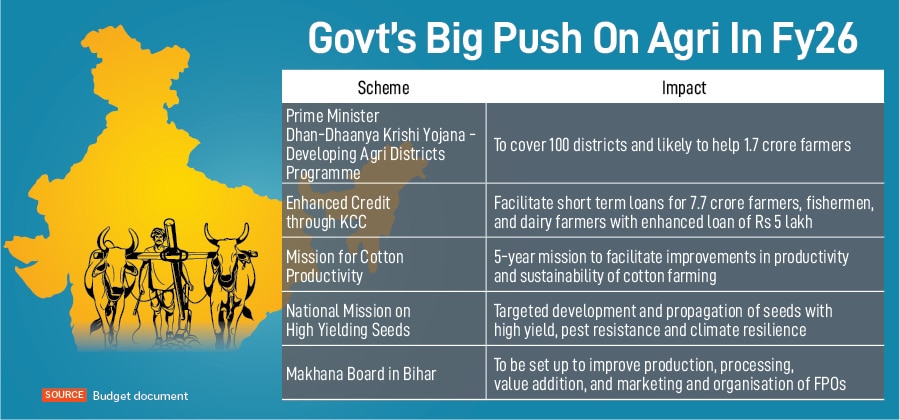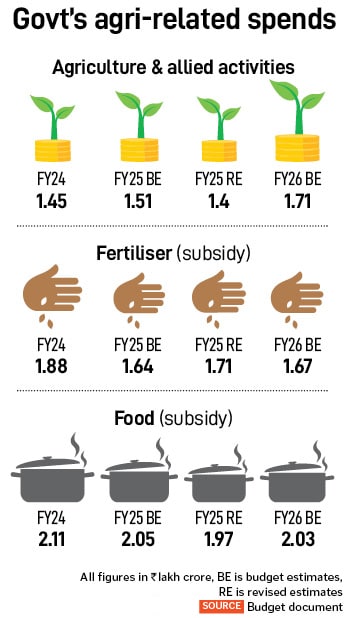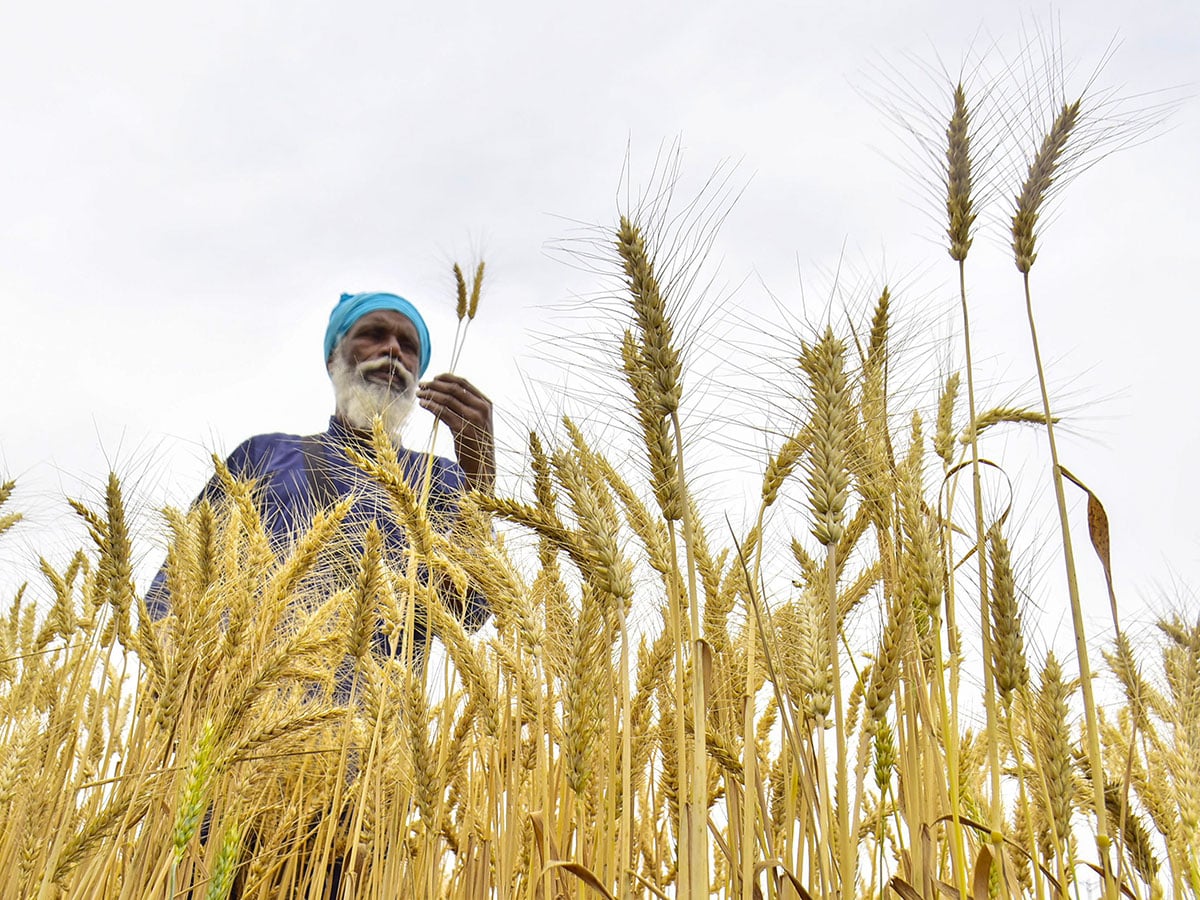Identifying agriculture as the first engine (out of four) of development, finance minister Nirmala Sitharaman said in her presentation in Parliament, “In this Budget, the proposed development measures span ten broad areas focusing on garib (poor), youth, annadata (farmers) and nari (women).”
The government proposes to spend Rs 1.71 lakh crore in FY26 on agriculture and allied activities. This compares to Rs 1.4 lakh crore in revised estimates in FY25 from Rs 1.51 lakh crore as proposed in the budget of the same year.
“Overall, in line with expectations, the government continues its emphasis on infrastructure, agri sector and ‘startups’ ecosystem. If executed properly, the budget is likely to revitalise the Indian economy, which has been experiencing a slowdown,” says Sanjay Sanghvi, partner, Khaitan & Co.
Aimed at helping 1.7 crore farmers, the government announced a new scheme for agriculture called ‘Prime Minister Dhan-Dhaanya Krishi Yojana’ in partnership with states. Through the convergence of existing schemes and specialised measures, the programme will cover 100 districts with low productivity, moderate crop intensity and below average credit parameters.
Also read: Budget 2025: Focus on growth and fiscal consolidation
The programme aims to enhance agricultural productivity, adopt crop diversification and sustainable agriculture practices, augment post-harvest storage at the panchayat and block level, improve irrigation facilities, and facilitate availability of long-term and short-term credit.
In the past, repetitive food price shocks have highlighted the importance of raising investment in cold storage and agriculture infrastructure to shield farmers from excessive food price fluctuations.
The government also plans to launch a multi-sectoral programme ‘Rural Prosperity and Resilience’ in partnership with states. “This will address under-employment in agriculture through skilling, investment, technology, and invigorating the rural economy. The goal is to generate ample opportunities in rural areas so that migration is an option, but not a necessity,” Sitharaman said.

The government proposed to launch a six-year “Mission for Aatmanirbharta in Pulses” with a special focus on tur, urad and masoor.
With a focus to promote production, efficient supplies, processing, and remunerative prices for farmers, the government also aims to launch a programme for vegetables and fruits.
A Makhana Board will be established in Bihar to improve production, processing, value addition, and marketing of makhana. The people engaged in these activities will be organised into FPOs. The board will provide handholding and training support to makhana farmers and will also work to ensure they receive the benefits of all relevant government schemes.
 The government has also proposed a national mission on high yielding seeds to be launched, aimed at strengthening the research ecosystem, targeted development and propagation of seeds with high yield, pest resistance and climate resilience, and commercial availability of more than 100 seed varieties released since July 2024.
The government has also proposed a national mission on high yielding seeds to be launched, aimed at strengthening the research ecosystem, targeted development and propagation of seeds with high yield, pest resistance and climate resilience, and commercial availability of more than 100 seed varieties released since July 2024.
According to Saugata Gupta, MD and CEO, Marico, the allocation fund to agriculture and allied activities, coupled with initiatives like the’ National Mission for Edible Oilseeds’, ‘Aatmanirbharta in Pulses’, and the’ Prime Minister Dhan-Dhaanya Krishi Yojana’ will drive agricultural productivity, stabilise rural economies, and ensure farmers have access to essential resources. “In the realm of health and nutrition, the enhancement of cost norms for nutritional support programs like Saksham Anganwadi and Poshan 2.0 is a significant step,” he adds.
Also read: Data is the new tractor for agriculture: Jeff Rowe, CEO, Syngenta Group
Meanwhile, for fisheries, the government will bring in an enabling framework for sustainable harnessing of fisheries from Indian Exclusive Economic Zone and High Seas, with a special focus on the Andaman & Nicobar and Lakshadweep Islands.
Aimed at boosting cotton productivity, the government proposed a mission for cotton productivity. “This five-year mission will facilitate significant improvements in productivity and sustainability of cotton farming, and promote extra-long staple cotton varieties,” the FM said.
Lastly, to promote enhanced credit for farmers, the government has proposed Kisan Credit Cards (KCC) to facilitate short-term loans for 7.7 crore farmers, fishermen, and dairy farmers. The loan limit under the modified interest subvention scheme will be enhanced from Rs 3 lakh to Rs 5 lakh for loans taken through the KCC.
“The government’s decision to enhance the short-term loan limit under KCC is expected to drive growth in India’s credit card market,” Raj Gaikar, research analyst, Samco Securities, says. He adds that public sector banks such as SBI, Union Bank, and Canara Bank, which actively extend KCC loans, are likely to see a boost in lending revenue. Additionally, private sector leaders in the credit card segment, including HDFC Bank and Axis Bank, stand to benefit from increased credit adoption, further strengthening their market position.
https://www.youtube.com/watch?v=/W6rNPILiX0s
 Aimed at helping 1.7 crore farmers, the government announced a new scheme for agriculture called ‘Prime Minister Dhan-Dhaanya Krishi Yojana’ in partnership with states. Image: Sameer Sehgal/Hindustan Times via Getty Images
Aimed at helping 1.7 crore farmers, the government announced a new scheme for agriculture called ‘Prime Minister Dhan-Dhaanya Krishi Yojana’ in partnership with states. Image: Sameer Sehgal/Hindustan Times via Getty Images

 The government has also proposed a national mission on high yielding seeds to be launched, aimed at strengthening the research ecosystem, targeted development and propagation of seeds with high yield, pest resistance and climate resilience, and commercial availability of more than 100 seed varieties released since July 2024.
The government has also proposed a national mission on high yielding seeds to be launched, aimed at strengthening the research ecosystem, targeted development and propagation of seeds with high yield, pest resistance and climate resilience, and commercial availability of more than 100 seed varieties released since July 2024.